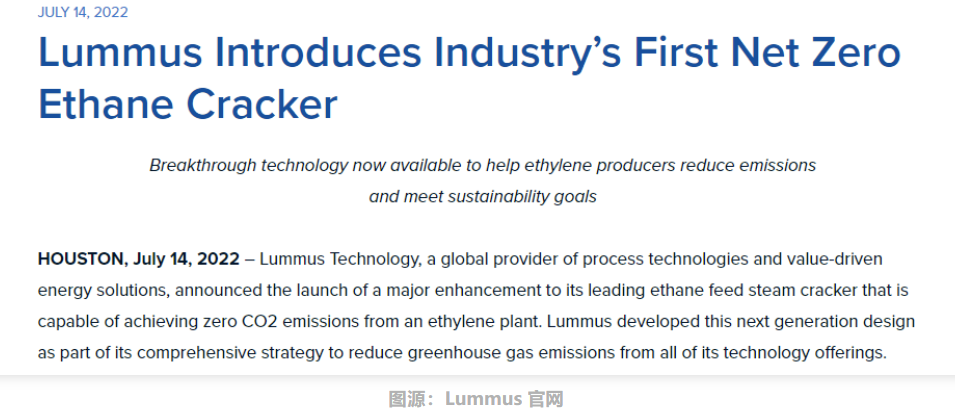Lummus Launches Industry’s First Net-Zero Emissions Ethane Cracker
Latest News: Lummus Technology (Lummus Technology Company) announced that it has carried out a major transformation and upgrade of the ethane cracking furnace, and achieved zero carbon dioxide emissions from the ethylene plant. The design developed by Lummus will be part of its comprehensive strategy to reduce greenhouse gas emissions from all technology products.

This is the ethylene industry’s first zero-CO2 cracker and is currently in commercial use. Mainly used for decarbonization in petrochemical manufacturing, which is a very carbon-intensive process. It can be integrated into new and existing ethane crackers, as well as sites and facilities of different sizes.
Leon de Lummus Technology President and CEO
“Ethylene producers are looking for solutions to reduce the carbon footprint of their investments, and this new net-zero ethane cracker will help them achieve their decarbonization goals,” Bruyn said. “By launching the world’s first zero-CO2 ethane cracker, We are leveraging Lummus’ innovative culture and proven technology commercialization capabilities to play a key role in the energy transition. ”
Combustion of methane or other carbon-based fuels can be eliminated through innovations in cracking heater design, resulting in a significant reduction in fuel combustion requirements, an enhancement of the recovery section, and a partial switchover of the primary compressor from a steam turbine to an electric drive.
Lummus Technology
A world-recognized leader in ethylene production technology, with approximately 40% of licensed capacity worldwide, enables the company to further develop and promote green ethylene through its technical capabilities and technology licensing expertise technology.
Recently, Lummus has made frequent moves in China:
On July 1st, Lummus Technologies, a global provider of process technologies and value-driven energy solutions, and its catalyst partner Clariant, announced that Qingdao Jinneng New Materials Co., Ltd. tons of CATOFIN®
The PDH device was successfully driven and passed the performance assessment with excellent results.
Propane Dehydrogenation (PDH) of Shandong Ruize Chemical Technology Co., Ltd. on June 29
The device debugged and started successfully. Located in Zibo City, Shandong Province, China, the plant has a capacity of 300,000 tons/year and uses Lummus’ world-class CATOFIN® PDH
technology to produce propylene. The unit is also part of a planned transition from refining to petrochemicals at the Shandong Ruize complex.
On May 30, the propane dehydrogenation unit of Zibo Xintai Petrochemical Co., Ltd. successfully started up and produced qualified propylene products. The unit adopts the CATOFIN® technology of Lummus, with a designed propylene production capacity of 300,000 tons/year, providing propylene raw materials for the follow-up green low-carbon olefin integration project of Xintai Petrochemical.
On May 25, Lummus and catalyst partner Clariant have won a major contract from Fujian Midea to supply CATOFIN technology and catalysts for a new world-scale propane dehydrogenation (PDH) unit in Fuzhou, China. Fujian Meide already operates a PDH unit at its Fuzhou Petrochemical Complex, and is currently building one of the largest PDH units in the world, and has selected the CATOFIN process and catalyst for the second phase of the project. The new unit, which will produce 900,000 metric tons of propylene per year, is scheduled to begin operations in 2023.
On February 17, Lummus Technologies announced that Shandong Yulong Petrochemical Co., Ltd. has selected Lummus’ CDAlky® low temperature sulfuric acid alkylation technology for its new 400,000 ton/year alkylation unit. The unit will be part of Shandong Yulong’s 20 million ton refining and chemical integration project, an ultra-large complex in China’s Shandong province.


